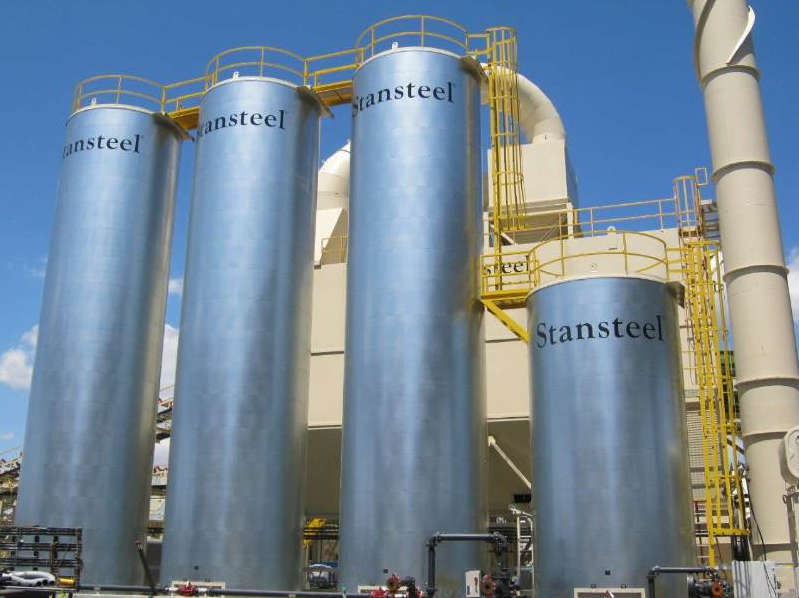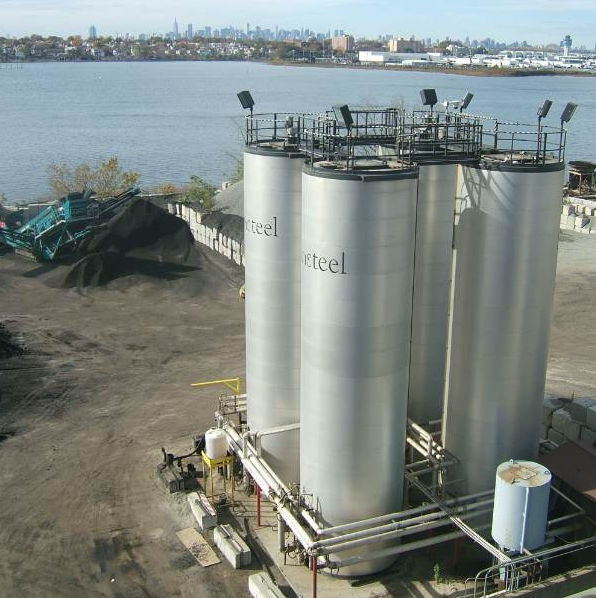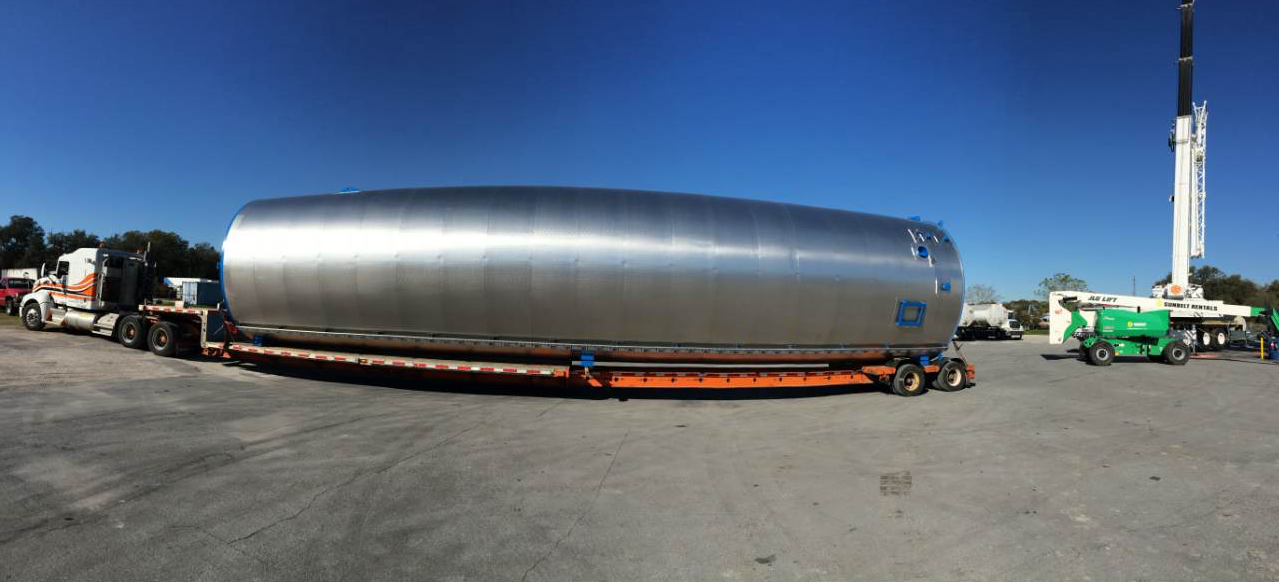Store More AC for Best Pricing Leverage
BY Sandy Lender

As we discussed in the Vol.9, No.3 issue of AsphaltPro, liquid asphalt cement (AC) prices have seen a most welcome decline as petroleum prices have decreased during 2015. The article “Slow Your Roll” from the December 2015 edition (online at www.TheAsphaltPro.com) shared information on specific price trends. It also offered tips for equipping the asphalt plant, and the owner, with tools for using both virgin and recycle material wisely. When considering the eventual increase AC prices will experience, producers want to stock up on material now. Let’s take a look at the creative options available for making storage an economic advantage. It’s not as simple as installing another 30,000-gallon tank with relevant piping and checking on insulation.
For example, Ron Heap of Tarmac International, Inc., Lee’s Summit, Missouri, explained, “The owner needs to have a large enough hot oil heater to heat the added tank.” This can help keep utility costs from surprising him when/if he adds to existing storage. He wants “only marginal cost added for the heater staying on longer to heat added storage.” Heap pointed out: “If this heat is natural gas, prices are low and falling for natural gas.”

“There are a number of the more sensitive or wider-range ACs that actually have a shelf life,” Stansteel’s Lennie Loesch said. 25,000 or 35,000 gallons of an AC that you only use intermittently would be costly to store and maintain if you must dispose of it when it no longer meets agency specs when you finally get a mix that calls for its use. Instead, Loesch suggested an inline plant blending system enables the producer to blend, condition and produce his own performance AC directly at the plant. It allows the producer to add anti-stripping agents or rejuvenators inline to soften RAP and RAS binders. Photo courtesy Stansteel/Hotmix Parts, Louisville, Kentucky.
Spice up Mixes With Variety
Phil Brady, regional sales manager for Heatec, Inc., Chattanooga, reminded producers that some of the factors that go into making the decision to increase storage capacity include the variety and the needs of the materials themselves. “How many asphalts are required, how far are suppliers, will trucking be internal or hired, what are the storage requirements of the materials—temperature, length of storage and mixing requirements.”
Jeff Meeker of Meeker Equipment Co., Inc., Belleville, Pennsylvania, shared that the purchases of “AC storage tanks have surged mostly due to the variety of liquid AC products on the market today. The industry is seeing different liquid AC is needed in different applications of hot mix asphalt (HMA).
“Many years ago, the industry was working with one or two grades of liquid AC at an asphalt plant,” Meeker continued. “Now we are seeing many more grades being specified. If a producer doesn’t have the room or space to store the liquid AC, a tank needs to be emptied to allow for the different liquid AC or the job waits. Jobs cannot wait and asphalt plants must produce. Multiple liquid AC tanks allow asphalt plants to be more flexible in the type of jobs coming out of the asphalt plant.”
Lennie Loesch of Stansteel/Hotmix Parts, Louisville, Kentucky, expanded on not only the materials concept, but also a second solution for handling multiple materials. “What makes things a little more complex for 2016 and beyond is the multiple grades of liquid AC that are now required for many projects. Thirty or 40 years ago, there were generally only one or two grades of liquid AC that would be required for the entire season of production. That made life simpler, but did not necessarily address all the demands of the different paving types and binder requirements. The advent of the Strategic Highway Research Project (SHRP), which the Federal Highway Administration (FHWA) spent over $55 million on (in 1990 dollars), was the beginning of performance grade (PG) asphalts and particularly the change in terminology for the range of temperatures and conditions in which each grade of AC needed to perform.
“Today, there may be requirements for multiple grades of liquid AC at a typical facility,” Loesch continued. “One of the complexities of using the different performance grades of AC is the need for specialized equipment. More storage capacity means a greater heating need for the increased volume, and for the elevated operating temperatures of some of the AC products. Increased piping needs and larger overflow containment areas are also required. In some cases, the more sensitive PGs need to be agitated or circulated to avoid separation of the constituents.”
The technology Stansteel/Hotmix Parts has developed to offer an alternative to using multiple tanks is the Accu-Shear Multi-Purpose Inline Plant Blending System, which lets the producer blend and condition multiple products onsite, eliminating the need for extra large or specially built tanks for storing grades that are infrequently used.
“Another advantage of having a system such as the Accu-Shear Advanced is the ability to produce many other special liquid AC blends,” Loesch continued. “There are now many liquid additive chemicals being required by states or agencies for anti-stripping and warm mix, or as rejuvenators. These inline modifiers can be used to alter existing asphalt that is hardened in the RAP or the RAS, to meter cutbacks used in the production of cold mix, and for foaming of the AC.”

Jeff Meeker explained that with the industry seeing many grades of liquid AC specified in a season, the producer needs additional tanks merely to stay up and running. “If a producer doesn’t have the room or space to store the liquid AC, a tank needs to be emptied to allow for the different liquid AC or the job waits. Jobs cannot wait and asphalt plants must produce. Multiple liquid AC tanks allow asphalt plants to be more flexible in the type of jobs coming out of the asphalt plant.” Photo courtesy Meeker Equipment Co., Inc., Belleville, Pennsylvania.
Get Creative, Remain Sensible
Of course producers still need storage tanks for the base: the liquid AC. If an owner has decided additional storage capacity is advantageous, he needs to find a place for it.
“The desire to inventory large volumes has sparked some creative measures,” Loesch shared.
“When an AC price escalation was forecasted about 10 years ago, one bold Southwest contractor did something about it. This innovative producer decided to build several high-volume underground concrete storage structures and fill them to capacity with nearly one million gallons of AC. This system not only allowed for high-volume storage, but enabled discounted purchasing of base AC in bulk—both off-season and during production. The ability to bulk-store AC virtually eliminated the previous years’ supply problems and also provided a more fixed cost of binder for bidding projects as known values.”
If you don’t have an underground storage facility, you can follow the experts’ advice for weighing the pros and cons of investing in more conventional storage.
Heatec’s Brady said to evaluate the existing system’s ability to handle new material types and increased heating loads. “Plan for running hot oil heaters at higher temperatures for PMA and to handle additional heating loads. Excess capacity of the heater along with flow calculations need to be considered when adding capacity. A lack of flow can cause poor or no heat boost and heaters may be compromised in their performance to the point of shutting off to prevent coil damage.”
Steve Degen, another regional sales manager for Heatec, also spoke to the quick return a producer could see from investing in increased storage capacity at this time. “It depends on the amount of work and the margin of work secured. Fuel costs are favorable with natural gas being low, so payback could come quickly.” Degen cautions against hidden costs.
“What…workload is anticipated? Is he modifying and does he want the expense of his own lab, which is very high? Does he have rail or barge availability for larger loads, cutting back on transportation costs?”
To keep utility costs from cutting too deeply into the ROI curve, Degen offered this advice: “Spend the money upfront on insulation on tanks and piping. Add proper pump size to keep flow rate at a proper level; temperature controllers.”
No matter how a producer elects to take advantage of prices, this is the time to do so. Steve Elam of Stansteel/Hotmix Parts shared, “Liquid AC prices are dramatically less than they have been in recent years, to the great relief of HMA contractors in North America. Current AC prices are on average over 30 percent lower than just under two years ago. While everyone understands that liquid AC is a key factor in determining the cost of a ton of hot mix, it is still often underestimated. Consider that the average amount of liquid AC in a ton of hot mix is approximately 5 percent, by volume. However, the cost of the liquid AC in a ton of hot mix has traditionally been nearly half of the total price. With this significant drop in the posted liquid AC price, along with the many “special deals” that some contractors are enjoying, more asphalt contractors are considering buying bulk storage of liquid AC on the spot market.”
